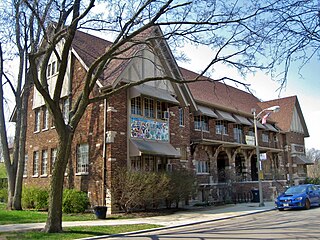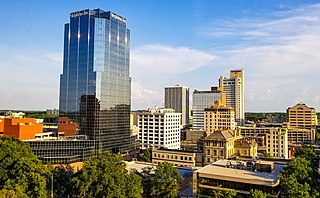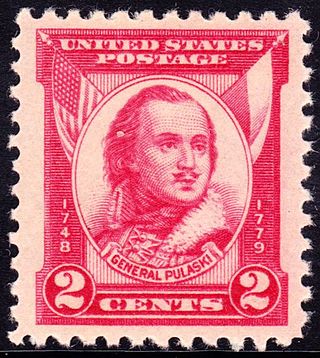
Pulaski Heights is a section of the city of Little Rock, Arkansas, located in the north-central portion of the city. 34°45′26″N92°19′01″W / 34.757198°N 92.317032°W Locally, the area is referred to as the Heights.

Pulaski Heights is a section of the city of Little Rock, Arkansas, located in the north-central portion of the city. 34°45′26″N92°19′01″W / 34.757198°N 92.317032°W Locally, the area is referred to as the Heights.
The Pulaski Heights neighborhood was historically an affluent area of Little Rock and incorporated on August 1, 1905. [1] The heavily wooded area grew from a few dozen families in the 1890s, to more than 300 once electricity and streetcars began to reach the area. A weekly newspaper, the Pulaskian, was written and published in the neighborhood. [2]
The area remained an independent community until 1916, when the residents voted to become Little Rock's Ninth Ward for the advantages of becoming an incorporated neighborhood, including a fire station. Eventually, the Pulaski Heights neighborhood broke into two smaller neighborhoods: the Heights and Hillcrest.
On March 31, 1960, a B-47 bomber exploded over the neighborhood, with the nose cone being found in Allsopp Park. [3] The craft took off from the nearby Little Rock Air Force Base with an intended destination of Barksdale Air Force Base in Shreveport, Louisiana. Three of the four crew members did not survive. [4] [5] Two civilians were also killed in the incident. [6]
Mount St. Mary's Academy and Convent, founded in 1851 in downtown Little Rock, moved to a 10-acre site on Kavanaugh Blvd in 1908. In doing so, they stopped instruction for boys and dropped "convent" from their name. Mount St. Mary's Academy is the oldest educational institution in continuous operation in the state of Arkansas. [7] It would be 1930 before the Little Rock Catholic High School was built nearby to serve the areas male Catholic students. [8]
Pulaski Heights Middle School was founded for the area residents in 1908, at the corner of Prospect and Oak Streets. Today, those streets are named Lee Avenue and Pine Street. [9]
Little Rock College, founded in 1908, moved to North Tyler Street in the Heights in 1916; however, the school would close due to the Great Depression with an announcement on July 12, 1930. [10]
The area boasts several parks including Knoop and Allsopp parks. Allsopp is a 150-acre park that was donated from the private lands of Frederick W. Allsopp, and Knoop Park has been the home to the Little Rock Water Works since 1886. [11] [12] The Country Club of Little Rock, built in 1902, is the oldest country club west of the Mississippi and is known for its exclusive and elite membership. There is an 18-hole golf course, dining room, and family center. [13]
Several notable architects were commissioned to build homes and businesses in the area including Charles L. Thompson and George R. Mann, who also designed the Arkansas State Capitol. Most homes are of Georgian, Tudor, Craftsman, and English Revival style. Unfortunately, there was a time the neighborhood was "white only" and disallowed people of color to buy or rent homes within the area. [14] This was outlawed in 1948, when the U.S. Supreme Court ruled racial covenants unconstitutional with the decision of Shelley v. Kraemer. [15]

Former Governor of Arkansas and President of the United States, Bill Clinton, and his wife, Hillary Rodham Clinton, lived in the neighborhood during the formers tenure as Arkansas Attorney General. The most famous resident to grow up in the neighborhood, however, was Helen Gurley Brown, the founder of Cosmopolitan magazine and author of "Sex and the Single Girl." The Brown family moved to a home on Monroe Street in 1932 when Mr. Brown was running for political office. He died in an elevator accident in the state capitol in 1932, [17] and the remaining family moved to Los Angeles, California in 1937. [18] Frederick W. Allsopp, who is most known today for donating the land where Allsopp Park now sits, was also a resident of the area.
It is marked by boutiques and restaurants along Kavanaugh Boulevard, St. John's Seminary, and the Country Club of Little Rock. With an estimated population of 30,000 people, the Ninth Ward is now known as Ward 3, and represented by Kathy Webb as of 2024. [19]

Pulaski County is a county in the U.S. state of Arkansas. With a population of 399,125 as of the 2020 United States Census, it is the most populous county in Arkansas. The county is included in the Little Rock–North Little Rock–Conway metropolitan area. Its county seat is Little Rock, which is also Arkansas's capital and largest city.

North Little Rock is a city in Pulaski County, Arkansas, United States. It is the twin city of Little Rock. The population was 64,591 at the 2020 Census, making it the seventh-most populous city in Arkansas.

Albany Park is one of 77 well-defined community areas of Chicago. Located on the Northwest Side of the City of Chicago with the North Branch of the Chicago River forming its east and north boundaries, it includes the ethnically diverse Albany Park neighborhood, with one of the highest percentages of foreign-born residents of any Chicago neighborhood.

Central Arkansas, also known as the Little Rock metro, designated by the United States Office of Management and Budget as the Little Rock-North Little Rock-Conway Metropolitan Statistical Area, is the most populous metro area in the U.S. state of Arkansas. With an estimated 2020 population of 748,031, it is the most populated area in Arkansas. Located at the convergence of Arkansas's other geographic regions, the region's central location make Central Arkansas an important population, economic, education, and political center in Arkansas and the South. Little Rock is the state's capital and largest city, and the city is also home to two Fortune 500 companies, Arkansas Children's Hospital, and University of Arkansas for Medical Sciences (UAMS).

Irving Park is one of 77 officially designated Chicago community areas, and is located on the Northwest Side. It is bounded by the Chicago River on the east, the Milwaukee Road railroad tracks on the west, Addison Street on the south and Montrose Avenue on the north, west of Pulaski Road stretching to encompass the region between Belmont Avenue on the south and, roughly, Leland Avenue on the north. It is named after the American author Washington Irving.

Chevy Chase is a neighborhood in northwest Washington, D.C. It borders Chevy Chase, Maryland.

The Metro Streetcar, formerly known as the River Rail Streetcar, is a two line heritage streetcar system operating in Little Rock and North Little Rock, Arkansas. It has operated since November 1, 2004. Most recently expanded in 2007, the streetcar now operates over 3.4-mile (5.5 km) of track in a figure-eight loop pattern. The Metro Streetcar is operated by Rock Region Metro. In 2023, the system had a ridership of 22,600.

Arkansas Highway 10 is an east–west state highway in West Arkansas. The route runs 135.41 miles (217.92 km) from Oklahoma State Highway 120 near Hackett east to Interstate 30 in Little Rock, the state's capitol. The highway serves both the Fort Smith metropolitan area and the Little Rock – North Little Rock – Conway metropolitan area.
Hall High is a neighborhood located in the central portion of Little Rock, Arkansas. It is a largely residential area to the west of Pulaski Heights, and south of Tanglewood. Named for the city's Hall High School, the neighborhood is also widely considered as a part of the greater midtown section of Little Rock. The neighborhood is also home to the Catholic High School for Boys.

Mabelvale was a small, unincorporated train station town in southwestern Pulaski County, Arkansas, until being annexed into Little Rock following a special election that was held on May 3, 1973. The area today is part of Little Rock's seventh ward, although it retains a separate postal designation and ZIP code [72103] from most of the rest of the city. The neighborhood is currently represented on Little Rock's City Board of Directors by Brenda "B.J." Wyrick.

Hillcrest Historic District is an historic neighborhood in Little Rock, Arkansas that was listed on the National Register of Historic Places on December 18, 1990. It is often referred to as Hillcrest by the people who live there, although the district's boundaries actually encompass several neighborhood additions that were once part of the incorporated town of Pulaski Heights. The town of Pulaski Heights was annexed to the city of Little Rock in 1916. The Hillcrest Residents Association uses the tagline "Heart of Little Rock" because the area is located almost directly in the center of the city and was the first street car suburb in Little Rock and among the first of neighborhoods in Arkansas.

The Arkansas Governor's Mansion is the official residence of the governor of Arkansas and Arkansas' first family. The mansion is located at 1800 Center Street in Little Rock, and is included in the Governor's Mansion Historic District, a district that is listed on the National Register of Historic Places. Notable former residents include later president Bill Clinton and Politician turned TV presenter Mike Huckabee.

Capitol View/Stifft's Station is a neighborhood of Little Rock, Arkansas, in the west-central portion of the city with approximately 1500 homes. Roughly, its boundaries include the area south of West Markham, north of Interstate 630, east of Pine, and west of Summit, as well as south of Riverview between Park and Summit. Capitol View/Stifft's Station is just west of Downtown, north of the Central High School Historic District, southeast of Pulaski Heights and uses the 72205 ZIP code.

Little Rock is the capital and largest city of the U.S. state of Arkansas. The city's population was 202,591 as of the 2020 census. The six-county Little Rock metropolitan area is the 81st-most populous in the United States with 748,031 residents according to the 2020 census.

Rock Region Metropolitan Transit Authority, is the largest transit agency in Arkansas. It was formerly known as the Central Arkansas Transit Authority. Rock Region Metro provides public transportation services within Pulaski County, Arkansas, seven days a week.

Casimir Pulaski was a Polish nobleman, soldier and military commander who has been called "the father of the American cavalry". He has had hundreds of monuments, memorial plaques, streets, parks and similar objects named after him.
The following is a timeline of the history of the city of Little Rock, Arkansas, US.
Little Rock, Arkansas is home to numerous neighborhoods. See List of Little Rock Neighborhoods for an exhaustive list.

The Pulaskian was a short-lived newspaper, published in Pulaski County, Arkansas from 1915 to 1929.